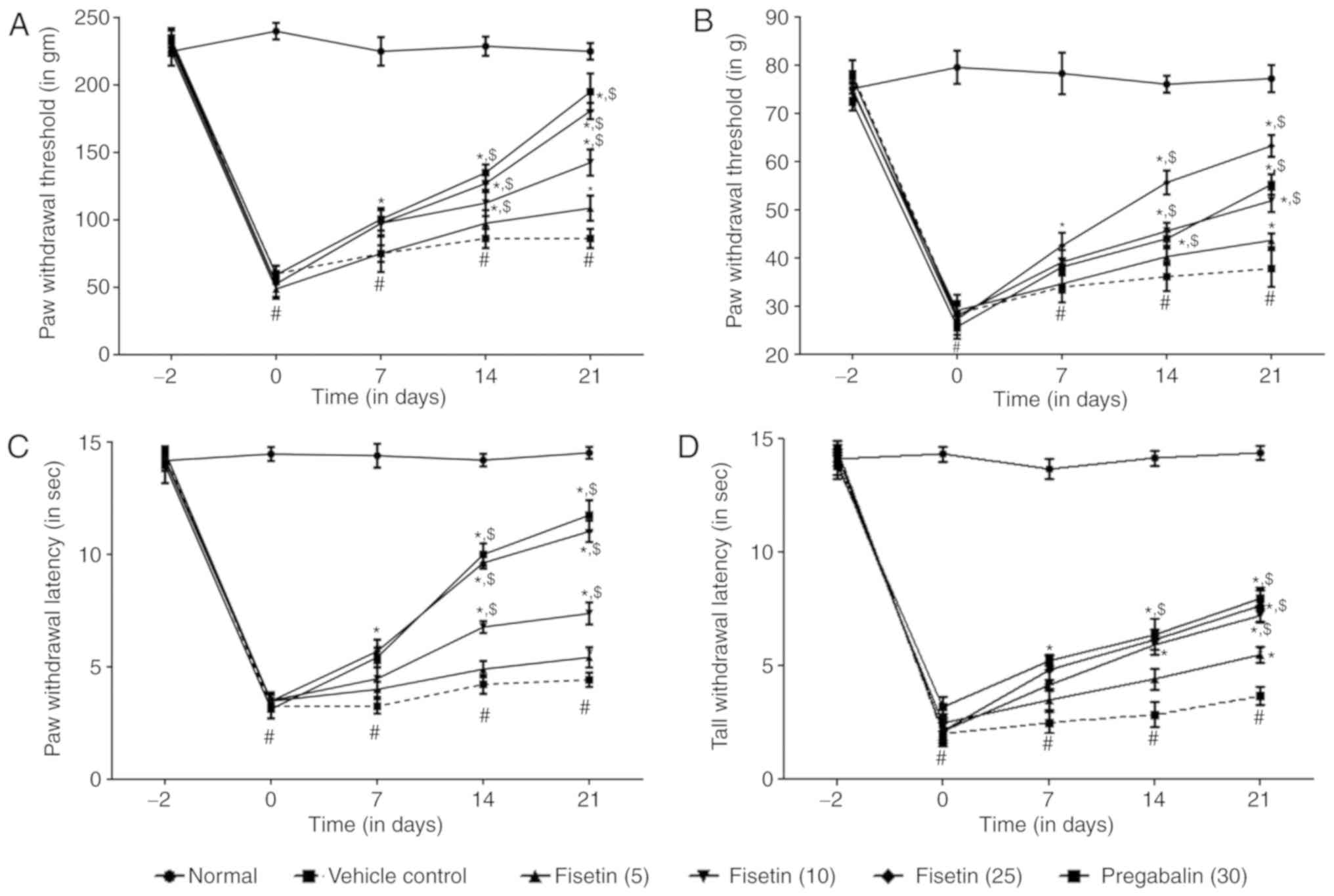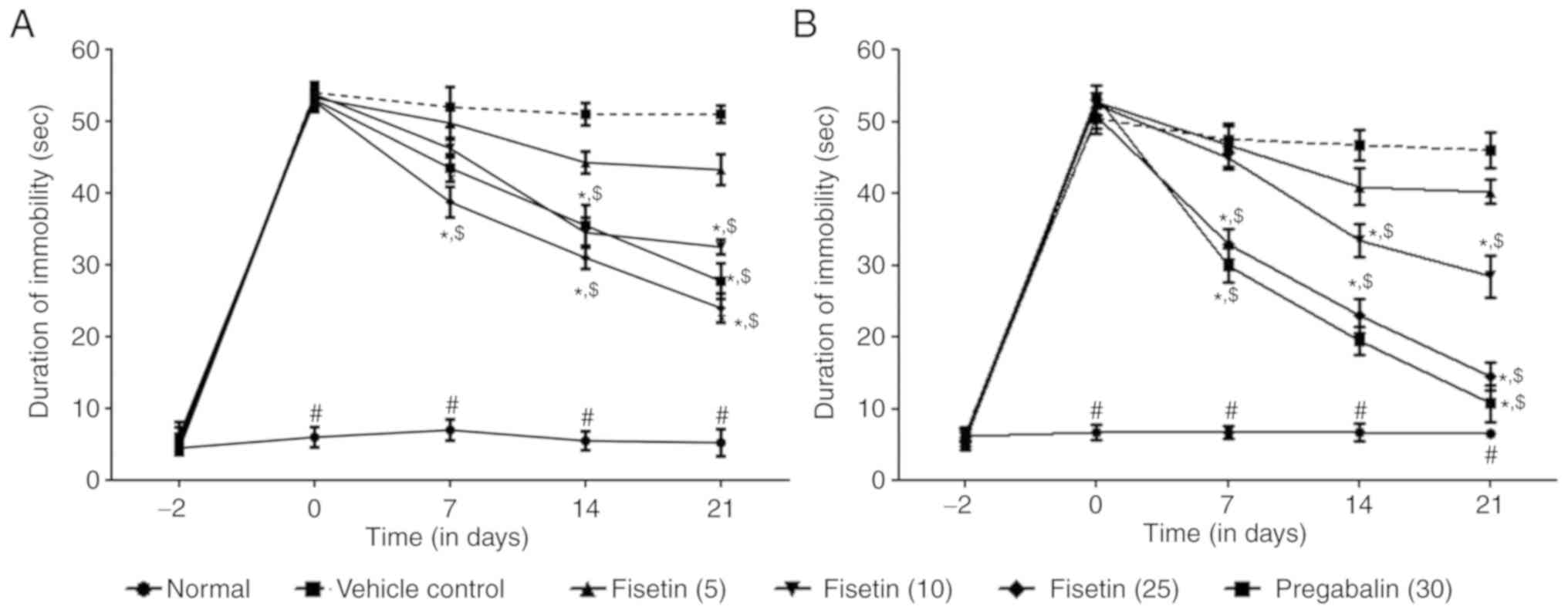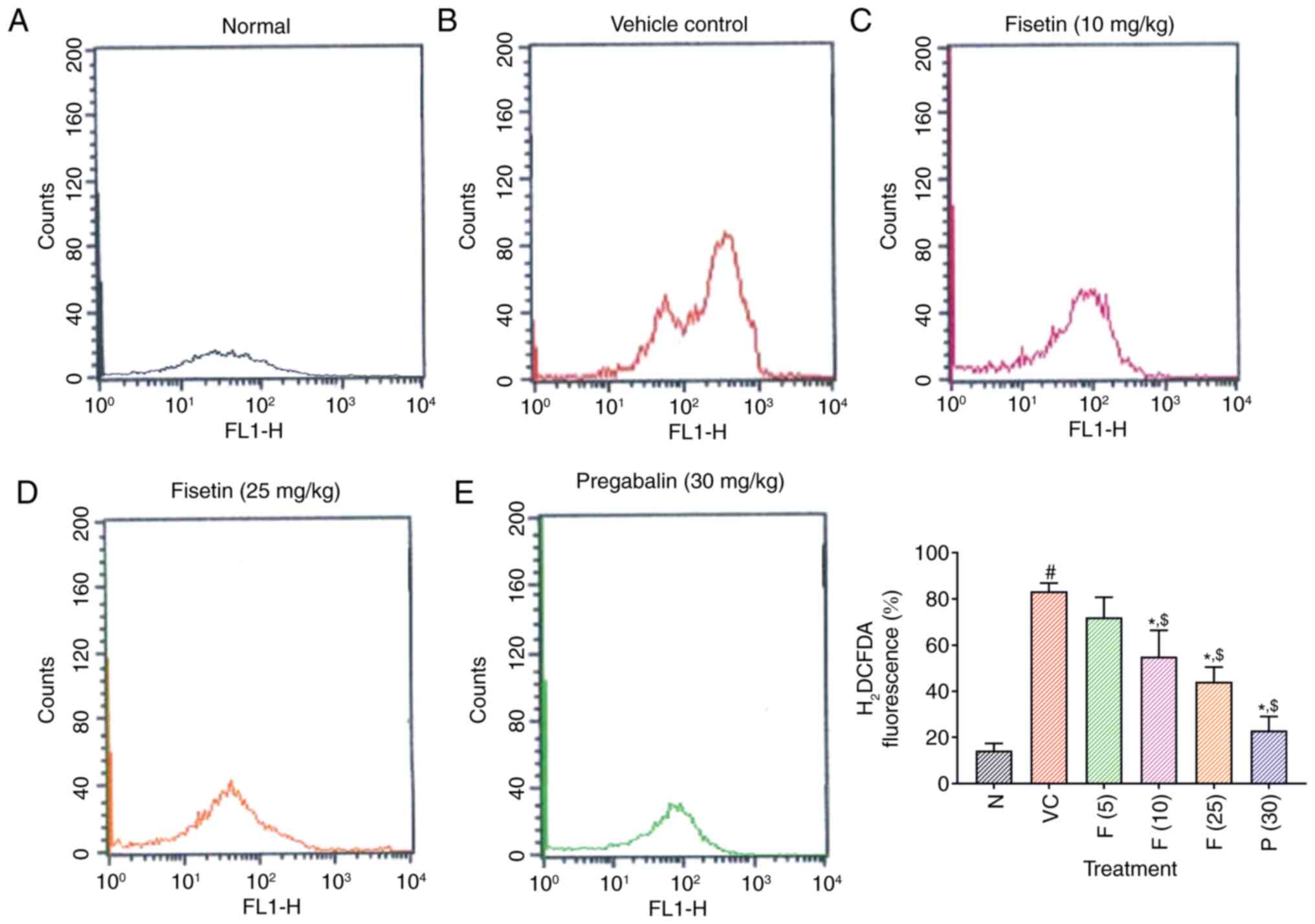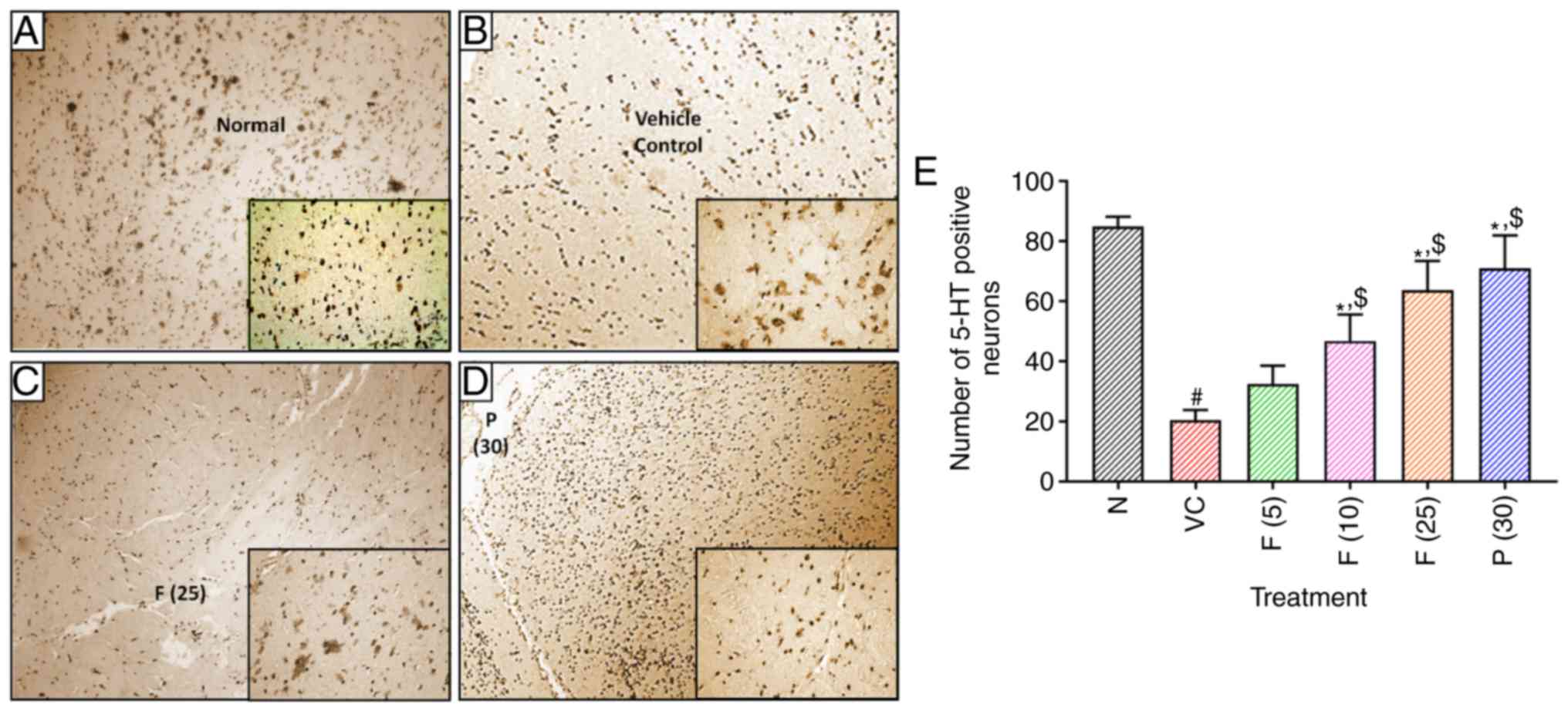|
1
|
Maletic V and Raison CL: Neurobiology of
depression, fibromyalgia and neuropathic pain. Front Biosci
(Landmark Ed). 14:5291–5338. 2009. View
Article : Google Scholar : PubMed/NCBI
|
|
2
|
Staud R and Rodriguez ME: Mechanisms of
disease: Pain in fibromyalgia syndrome. Nat Clin Pract Rheumatol.
2:90–98. 2006. View Article : Google Scholar : PubMed/NCBI
|
|
3
|
Walitt B, Nahin RL, Katz RS, Bergman MJ
and Wolfe F: The prevalence and characteristics of fibromyalgia in
the 2012 national health interview survey. PLoS One.
10:e01380242015. View Article : Google Scholar : PubMed/NCBI
|
|
4
|
Borchers AT and Gershwin ME: Fibromyalgia:
A critical and comprehensive review. Clin Rev Allergy Immunol.
49:100–151. 2015. View Article : Google Scholar : PubMed/NCBI
|
|
5
|
Arnold LM: Biology and therapy of
fibromyalgia. New therapies in fibromyalgia. Arthritis Res Ther.
8:2122006. View
Article : Google Scholar : PubMed/NCBI
|
|
6
|
Ghavidel-Parsa B, Bidari A, Amir Maafi A
and Ghalebaghi B: the iceberg nature of fibromyalgia burden: The
clinical and economic aspects. Korean J Pain. 28:169–176. 2015.
View Article : Google Scholar : PubMed/NCBI
|
|
7
|
Wood PB, Holman AJ and Jones KD: Novel
pharmacotherapy for fibromyalgia. Expert Opin Investig Drugs.
16:829–841. 2007. View Article : Google Scholar : PubMed/NCBI
|
|
8
|
Dadabhoy D, Crofford LJ, Spaeth M, Russell
IJ and Clauw DJ: Biology and therapy of fibromyalgia.
Evidence-based biomarkers for fibromyalgia syndrome. Arthritis Res
Ther. 10:2112008. View
Article : Google Scholar : PubMed/NCBI
|
|
9
|
Russell IJ, Vaeroy H, Javors M and Nyberg
F: Cerebrospinal fluid biogenic amine metabolites in
fibromyalgia/fibrositis syndrome and rheumatoid arthritis.
Arthritis Rheum. 35:550–556. 1992. View Article : Google Scholar : PubMed/NCBI
|
|
10
|
Mense S: Neurobiological concepts of
fibromyalgia-the possible role of descending spinal tracts. Scand J
Rheumatol Suppl. 113:24–29. 2000. View Article : Google Scholar : PubMed/NCBI
|
|
11
|
Wasik A, Romanska I and
Antkiewicz-Michaluk L: 1-Benzyl-1,2,3,4-tetrahydroisoquinoline, an
endogenous parkinsonism-inducing toxin, strongly potentiates
MAO-dependent dopamine oxidation and impairs dopamine release: Ex
vivo and in vivo neurochemical studies. Neurotox Res. 15:15–23.
2009. View Article : Google Scholar : PubMed/NCBI
|
|
12
|
Sánchez-Domínguez B, Bullón P, Román-Malo
L, Marín-Aguilar F, Alcocer-Gómez E, Carrión AM, Sánchez-Alcazar JA
and Cordero MD: Oxidative stress, mitochondrial dysfunction and,
inflammation common events in skin of patients with fibromyalgia.
Mitochondrion. 21:69–75. 2015. View Article : Google Scholar : PubMed/NCBI
|
|
13
|
Bjorklund G, Dadar M, Chirumbolo S and
Aaseth J: Fibromyalgia and nutrition: Therapeutic possibilities?
Biomed Pharmacother. 103:531–538. 2018. View Article : Google Scholar : PubMed/NCBI
|
|
14
|
Cordero MD, de Miguel M, Carmona-López I,
Bonal P, Campa F and Moreno-Fernández AM: Oxidative stress and
mitochondrial dysfunction in fibromyalgia. Neuro Endocrinol Lett.
31:169–173. 2010.PubMed/NCBI
|
|
15
|
Bateman L, Palmer RH, Trugman JM and Lin
Y: Results of switching to milnacipran in fibromyalgia patients
with an inadequate response to duloxetine: A phase IV pilot study.
J Pain Res. 6:311–318. 2013. View Article : Google Scholar : PubMed/NCBI
|
|
16
|
Siler AC, Gardner H, Yanit K, Cushman T
and McDonagh M: Systematic review of the comparative effectiveness
of antiepileptic drugs for fibromyalgia. J Pain. 12:407–415. 2011.
View Article : Google Scholar : PubMed/NCBI
|
|
17
|
Younger J, Noor N, McCue R and Mackey S:
Low-dose naltrexone for the treatment of fibromyalgia: Findings of
a small, randomized, double-blind, placebo-controlled,
counterbalanced, crossover trial assessing daily pain levels.
Arthritis Rheum. 65:529–538. 2013. View Article : Google Scholar : PubMed/NCBI
|
|
18
|
Hadikusumo B and Ng B: Serotonin syndrome
induced by duloxetine. Aust N Z J Psychiatry. 43:581–582.
2009.PubMed/NCBI
|
|
19
|
Nüesch E, Häuser W, Bernardy K, Barth J
and Jüni P: Comparative efficacy of pharmacological and
non-pharmacological interventions in fibromyalgia syndrome: Network
meta-analysis. Ann Rheum Dis. 72:955–962. 2013. View Article : Google Scholar : PubMed/NCBI
|
|
20
|
Hussain SA, Al K II, Jasim NA and Gorial
FI: Adjuvant use of melatonin for treatment of fibromyalgia. J
Pineal Res. 50:267–271. 2011. View Article : Google Scholar : PubMed/NCBI
|
|
21
|
Gilron I, Tu D, Holden R, Towheed T,
Ziegler D, Wang L, Milev R and Gray C: Innovations in the
management of musculoskeletal pain with alpha-lipoic acid (IMPALA
Trial): Study protocol for a double-blind, randomized,
placebo-controlled crossover trial of alpha-lipoic acid for the
treatment of fibromyalgia pain. JMIR Res Protoc. 6:e412017.
View Article : Google Scholar : PubMed/NCBI
|
|
22
|
Nagakura Y: Recent advancements in animal
models of fibromyalgia. Myopain. 23:104–111. 2015. View Article : Google Scholar
|
|
23
|
La Torre F and Nicolai AP: Clinical use of
micronized purified flavonoid fraction for treatment of symptoms
after hemorrhoidectomy: Results of a randomized, controlled,
clinical trial. Dis Colon Rectum. 47:704–710. 2004. View Article : Google Scholar : PubMed/NCBI
|
|
24
|
Fiorani M, Accorsi A and Cantoni O: Human
red blood cells as a natural flavonoid reservoir. Free Radic Res.
37:1331–1338. 2003. View Article : Google Scholar : PubMed/NCBI
|
|
25
|
Maher P, Dargusch R, Bodai L, Gerard PE,
Purcell JM and Marsh JL: ERK activation by the polyphenols fisetin
and resveratrol provides neuroprotection in multiple models of
Huntington's disease. Hum Mol Genet. 20:261–270. 2011. View Article : Google Scholar : PubMed/NCBI
|
|
26
|
Mazzio EA, Harris N and Soliman KF: Food
constituents attenuate monoamine oxidase activity and peroxide
levels in C6 astrocyte cells. Planta Med. 64:603–606. 1998.
View Article : Google Scholar : PubMed/NCBI
|
|
27
|
Maher P: The flavonoid fisetin promotes
nerve cell survival from trophic factor withdrawal by enhancement
of proteasome activity. Arch Biochem Biophys. 476:139–144. 2008.
View Article : Google Scholar : PubMed/NCBI
|
|
28
|
Maher P: Modulation of multiple pathways
involved in the maintenance of neuronal function during aging by
fisetin. Genes Nutr. 4:297–307. 2009. View Article : Google Scholar : PubMed/NCBI
|
|
29
|
Maher P, Dargusch R, Ehren JL, Okada S,
Sharma K and Schubert D: Fisetin lowers methylglyoxal dependent
protein glycation and limits the complications of diabetes. PLoS
One. 6:e212262011. View Article : Google Scholar : PubMed/NCBI
|
|
30
|
Kandhare AD, Raygude KS, Ghosh P and
Bodhankar SL: The ameliorative effect of fisetin, a bioflavonoid,
on ethanol-induced and pylorus ligation-induced gastric ulcer in
rats. Inter J Green Pharmacy. 5:236–243. 2011. View Article : Google Scholar
|
|
31
|
Raygude KS, Kandhare AD, Ghosh P and
Bodhankar SL: Anticonvulsant effect of fisetin by modulation of
endogenous biomarkers. Biomed Prev Nutr. 2:215–222. 2012.
View Article : Google Scholar
|
|
32
|
Zhao L, Kandhare A, Mukherjee A and
Bodhankar S: Anti-allergic potential of fisetin in a murine model
of OVA-induced allergic rhinitis via inhibition of GATA-3 and Th2
cytokines. Biomedica. 34:88–101. 2018.
|
|
33
|
Ma T, Kandhare AD, Mukherjee-Kandhare AA
and Bodhankar SL: Fisetin, a plant flavonoid ameliorates
doxorubicin-induced cardiotoxicity in experimental rats: The
decisive role of caspase-3, COX–II, cTn-I, iNOs and TNF-α. Mol Biol
Rep. 46:105–118. 2019. View Article : Google Scholar : PubMed/NCBI
|
|
34
|
Zhen L, Zhu J, Zhao X, Huang W, An Y, Li
S, Du X, Lin M, Wang Q, Xu Y and Pan J: The antidepressant-like
effect of fisetin involves the serotonergic and noradrenergic
system. Behav Brain Res. 228:359–366. 2012. View Article : Google Scholar : PubMed/NCBI
|
|
35
|
CPCSEA: Committee for the purpose of
control and supervision of experiments on animals. 1991.
|
|
36
|
Nagakura Y, Oe T, Aoki T and Matsuoka N:
Biogenic amine depletion causes chronic muscular pain and tactile
allodynia accompanied by depression: A putative animal model of
fibromyalgia. Pain. 146:26–33. 2009. View Article : Google Scholar : PubMed/NCBI
|
|
37
|
Kamble H, Kandhare AD, Bodhankar S, Mohan
V and Thakurdesai P: Effect of low molecular weight galactomannans
from fenugreek seeds on animal models of diabetes mellitus. Biomed
Aging Pathol. 3:145–151. 2013. View Article : Google Scholar
|
|
38
|
Kandhare AD, Raygude KS, Ghosh P, Ghule AE
and Bodhankar SL: Neuroprotective effect of naringin by modulation
of endogenous biomarkers in streptozotocin induced painful diabetic
neuropathy. Fitoterapia. 83:650–659. 2012. View Article : Google Scholar : PubMed/NCBI
|
|
39
|
Kandhare AD, Raygude KS, Ghosh P, Ghule AE
and Bodhankar SL: Therapeutic role of curcumin in prevention of
biochemical and behavioral aberration induced by alcoholic
neuropathy in laboratory animals. Neurosci Lett. 511:18–22. 2012.
View Article : Google Scholar : PubMed/NCBI
|
|
40
|
Adil M, Kandhare AD, Dalvi G, Ghosh P,
Venkata S, Raygude KS and Bodhankar SL: Ameliorative effect of
berberine against gentamicin-induced nephrotoxicity in rats via
attenuation of oxidative stress, inflammation, apoptosis and
mitochondrial dysfunction. Ren Fail. 38:996–1006. 2016. View Article : Google Scholar : PubMed/NCBI
|
|
41
|
Adil M, Kandhare AD, Ghosh P and Bodhankar
SL: Sodium arsenite-induced myocardial bruise in rats: Ameliorative
effect of naringin via TGF-β/Smad and Nrf/HO pathways. Chem Biol
Interact. 253:66–77. 2016. View Article : Google Scholar : PubMed/NCBI
|
|
42
|
Kandhare AD, Alam J, Patil MV, Sinha A and
Bodhankar SL: Wound healing potential of naringin ointment
formulation via regulating the expression of inflammatory,
apoptotic and growth mediators in experimental rats. Pharm Biol.
54:419–432. 2016. View Article : Google Scholar : PubMed/NCBI
|
|
43
|
Kandhare AD, Raygude KS, Kumar VS, Rajmane
AR, Visnagri A, Ghule AE, Ghosh P, Badole SL and Bodhankar SL:
Ameliorative effects quercetin against impaired motor nerve
function, inflammatory mediators and apoptosis in neonatal
streptozotocin-induced diabetic neuropathy in rats. Biomed Aging
Pathol. 2:173–186. 2012. View Article : Google Scholar
|
|
44
|
Visnagri A, Kandhare AD and Bodhankar SL:
Renoprotective effect of berberine via intonation on apoptosis and
mitochondrial-dependent pathway in renal ischemia
reperfusion-induced mutilation. Ren Fail. 37:482–493. 2015.
View Article : Google Scholar : PubMed/NCBI
|
|
45
|
Blasco-Serra A, Escrihuela-Vidal F,
Gonzalez-Soler EM, Martínez-Expósito F, Blasco-Ausina MC,
Martínez-Bellver S, Cervera-Ferri A, Teruel-Martí V and
Valverde-Navarro AA: Depressive-like symptoms in a
reserpine-induced model of fibromyalgia in rats. Physiol Behav.
151:456–462. 2015. View Article : Google Scholar : PubMed/NCBI
|
|
46
|
Ghule AE, Kandhare AD, Jadhav SS, Zanwar
AA and Bodhankar SL: Omega-3-fatty acid adds to the protective
effect of flax lignan concentrate in pressure overload-induced
myocardial hypertrophy in rats via modulation of oxidative stress
and apoptosis. Int Immunopharmacol. 28:751–763. 2015. View Article : Google Scholar : PubMed/NCBI
|
|
47
|
Zhang L, Wu T, Kandhare A, Mukherjee A,
Guo G and Bodhankar S: Elucidation of the molecular mechanism of
tempol in pentylenetetrazol-induced epilepsy in mice: Role of
gamma-aminobutyric acid, tumor necrosis factor-alpha,
interleukin-1β and c-Fos. Pharm Mag. 14:520–527. 2018.
View Article : Google Scholar
|
|
48
|
Antkiewicz-Michaluk L, Wasik A, Możdżeń E,
Romańska I and Michaluk J: Antidepressant-like effect of
tetrahydroisoquinoline amines in the animal model of depressive
disorder induced by repeated administration of a low dose of
reserpine: Behavioral and neurochemical studies in the rat.
Neurotox Res. 26:85–98. 2014. View Article : Google Scholar : PubMed/NCBI
|
|
49
|
Horiuchi H, Ogata T, Morino T, Takeba J
and Yamamoto H: Serotonergic signaling inhibits hyperalgesia
induced by spinal cord damage. Brain Res. 963:312–320. 2003.
View Article : Google Scholar : PubMed/NCBI
|
|
50
|
Willis WD and Westlund KN: Neuroanatomy of
the pain system and of the pathways that modulate pain. J Clin
Neurophysiol. 14:2–31. 1997. View Article : Google Scholar : PubMed/NCBI
|
|
51
|
Legangneux E, Mora JJ, Spreux-Varoquaux O,
Thorin I, Herrou M, Alvado G and Gomeni C: Cerebrospinal fluid
biogenic amine metabolites, plasma-rich platelet serotonin and
[3H]imipramine reuptake in the primary fibromyalgia
syndrome. Rheumatology (Oxford). 40:290–296. 2001. View Article : Google Scholar : PubMed/NCBI
|
|
52
|
de Souza AH, da Costa Lopes AM, Castro CJ
Jr, Pereira EM, Klein CP, da Silva CA Jr, da Silva JF, Ferreira J
and Gomez MV: The effects of Phα1β, a spider toxin, calcium channel
blocker, in a mouse fibromyalgia model. Toxicon. 81:37–42. 2014.
View Article : Google Scholar : PubMed/NCBI
|
|
53
|
Borsook D, Moulton EA, Tully S, Schmahmann
JD and Becerra L: Human cerebellar responses to brush and heat
stimuli in healthy and neuropathic pain subjects. Cerebellum.
7:252–272. 2008. View Article : Google Scholar : PubMed/NCBI
|
|
54
|
Seifert F, Jungfer I, Schmelz M and
Maihofner C: Representation of UV-B-induced thermal and mechanical
hyperalgesia in the human brain: A functional MRI study. Hum Brain
Mapp. 29:1327–1342. 2008. View Article : Google Scholar : PubMed/NCBI
|
|
55
|
Kaufman J, DeLorenzo C, Choudhury S and
Parsey RV: The 5-HT1A receptor in major depressive disorder. Eur
Neuropsychopharmacol. 26:397–410. 2016. View Article : Google Scholar : PubMed/NCBI
|
|
56
|
Charbit AR, Akerman S and Goadsby PJ:
Comparison of the effects of central and peripheral dopamine
receptor activation on evoked firing in the trigeminocervical
complex. J Pharmacol Exp Ther. 331:752–763. 2009. View Article : Google Scholar : PubMed/NCBI
|
|
57
|
Pertovaara A: Noradrenergic pain
modulation. Prog Neurobiol. 80:53–83. 2006. View Article : Google Scholar : PubMed/NCBI
|
|
58
|
Zhao X, Li XL, Liu X, Wang C, Zhou DS, Ma
Q, Zhou WH and Hu ZY: Antinociceptive effects of fisetin against
diabetic neuropathic pain in mice: Engagement of antioxidant
mechanisms and spinal GABAA receptors. Pharmacol Res. 102:286–297.
2015. View Article : Google Scholar : PubMed/NCBI
|
|
59
|
Glass JM: Review of cognitive dysfunction
in fibromyalgia: A convergence on working memory and attentional
control impairments. Rheum Dis Clin North Am. 35:299–311. 2009.
View Article : Google Scholar : PubMed/NCBI
|
|
60
|
Surmeier DJ, Shen W, Day M, Gertler T,
Chan S, Tian X and Plotkin JL: The role of dopamine in modulating
the structure and function of striatal circuits. Prog Brain Res.
183:149–167. 2010.PubMed/NCBI
|
|
61
|
Belujon P and Grace AA: Dopamine system
dysregulation in major depressive disorders. Int J
Neuropsychopharmacol. 20:1036–1046. 2017. View Article : Google Scholar : PubMed/NCBI
|
|
62
|
Leith NJ and Barrett RJ: Effects of
chronic amphetamine or reserpine on self-stimulation responding:
Animal model of depression? Psychopharmacology (Berl). 72:9–15.
1980. View Article : Google Scholar : PubMed/NCBI
|
|
63
|
Franberg O, Marcus MM and Svensson TH:
Involvement of 5-HT2A receptor and α2-adrenoceptor blockade in the
asenapine-induced elevation of prefrontal cortical monoamine
outflow. Synapse. 66:650–660. 2012. View Article : Google Scholar : PubMed/NCBI
|
|
64
|
Kulkarni SK and Dhir A: On the mechanism
of antidepressant-like action of berberine chloride. Eur J
Pharmacol. 589:163–172. 2008. View Article : Google Scholar : PubMed/NCBI
|
|
65
|
Freitas AE, Budni J, Lobato KR, Binfaré
RW, Machado DG, Jacinto J, Veronezi PO, Pizzolatti MG and Rodrigues
AL: Antidepressant-like action of the ethanolic extract from
Tabebuia avellanedae in mice: Evidence for the involvement of the
monoaminergic system. Prog Neuropsychopharmacol Biol Psychiatry.
34:335–343. 2010. View Article : Google Scholar : PubMed/NCBI
|
|
66
|
Johnels B: Locomotor hypokinesia in the
reserpine-treated rat: Drug effects from the corpus striatum and
nucleus accumbens. Pharmacol Biochem Behav. 17:283–289. 1982.
View Article : Google Scholar : PubMed/NCBI
|
|
67
|
Kandhare AD, Mukherjee AA and Bodhankar
SL: Anti-epileptic effect of morin against experimental
pentylenetetrazol-induced seizures via modulating brain monoamines
and oxidative stress. Asian Pac J Trop Biomed. 8:352–359. 2018.
View Article : Google Scholar
|
|
68
|
Okifuji A, Gao J, Bokat C and Hare BD:
Management of fibromyalgia syndrome in 2016. Pain Manag. 6:383–400.
2016. View Article : Google Scholar : PubMed/NCBI
|
|
69
|
Cordero MD, Alcocer-Gómez E, Cano-Garcia
FJ, De Miguel M, Carrión AM, Navas P and Sánchez Alcázar JA:
Clinical symptoms in fibromyalgia are better associated to lipid
peroxidation levels in blood mononuclear cells rather than in
plasma. PLoS One. 6:e269152011. View Article : Google Scholar : PubMed/NCBI
|
|
70
|
Bilska A, Dubiel M, Sokolowska-Jezewicz M,
Lorenc-Koci E and Włodek L: Alpha-lipoic acid differently affects
the reserpine-induced oxidative stress in the striatum and
prefrontal cortex of rat brain. Neuroscience. 146:1758–1771. 2007.
View Article : Google Scholar : PubMed/NCBI
|
|
71
|
Cui J, Wang G, Kandhare AD,
Mukherjee-Kandhare AA and Bodhankar SL: Neuroprotective effect of
naringin, a flavone glycoside in quinolinic acid-induced
neurotoxicity: Possible role of PPAR-γ, Bax/Bcl-2, and caspase-3.
Food Chem Toxicol. 121:95–108. 2018. View Article : Google Scholar : PubMed/NCBI
|
|
72
|
Rajendran M and Ramachandran R: Fisetin
protects against rotenone-induced neurotoxicity through signaling
pathway. Front Biosci (Elite Ed). 11:20–28. 2019.PubMed/NCBI
|
|
73
|
Boomershine CS: Pregabalin for the
management of fibromyalgia syndrome. J Pain Res. 3:81–88. 2010.
View Article : Google Scholar : PubMed/NCBI
|
|
74
|
Kim L, Lipton S and Deodhar A: Pregabalin
for fibromyalgia: Some relief but no cure. Cleve Clin J Med.
76:255–261. 2009. View Article : Google Scholar : PubMed/NCBI
|
|
75
|
Gao GM, Jiang L, Liu SY, Zheng ZH and Liu
ZS: A randomized and controlled study of clinical efficacy for
total flavone of Rhizoma Drynariae on fibromyalgia syndrome.
Chin J New Drug Clin Remedies. 26:837–840. 2007.
|
|
76
|
Farsad-Naeimi A, Alizadeh M, Esfahani A
and Darvish Aminabad E: Effect of fisetin supplementation on
inflammatory factors and matrix metalloproteinase enzymes in
colorectal cancer patients. Food Funct. 9:2025–2031. 2018.
View Article : Google Scholar : PubMed/NCBI
|
|
77
|
Mehta P, Pawar A, Mahadik K and Bothiraja
C: Emerging novel drug delivery strategies for bioactive flavonol
fisetin in biomedicine. Biomed Pharmacother. 106:1282–1291. 2018.
View Article : Google Scholar : PubMed/NCBI
|


















